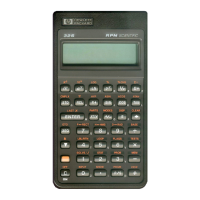Normalizing
Close,
Large
Numbers.
The calculator might be
un
able to correctly calculate
the
standard deviation
and
linear regression
for a variable whose data values differ by a relatively small amount.
Toavoid this, normalize the data by entering each value as the differ
ence from
one
central value (such as the mean). For normalized
re
values,
this
difference
must
then
be
added
back
to
the
calculation
of
x
and
x,
and
y
and
b must also be adjusted. For example, if your
re
values were 7776999, 7777000,
and
7777001, you should
enter
the
data
as
-1,
0,
and
1;
then
add
7777000
back
to
x
and
x.
For
b,
add
back 7777000 x m. To calculate y, be sure to supply an x-value that
is
less
7777000.
Similar inaccuracies can result if your x
and
y values have greatly
dif
ferent magnitudes. Again, scaling the data can avoid this problem.
Effect
of
Deleted
Data. Executing BCED does not delete any
rounding errors that might have been generated in the statistics regis
ters by the original data values. This difference is not serious unless
the incorrect data have a magnitude that is enormous compared with
the
correct
data;
in
such
a
case,
it
would
be
wise
to
clear
and
reenter
all
the
data.
Summation
Values
and
the
Statistics
Registers
The statistics registers are six unique locations in memory that store
the
accumulation
of
the
six
summation
values.
Summation
Statistics
Pressing
fill
stat
I
{2}
gives you access to the contents of the statistics
registers:
•
Press
{n}
to
see
the
number
of
accumulated
data
sets.
•
Press
{x}
to
see
the
sum
of
the
x-values.
• Press
{y}
to see the
sum
of the y-values.
11:
Statistical
Operations
161

